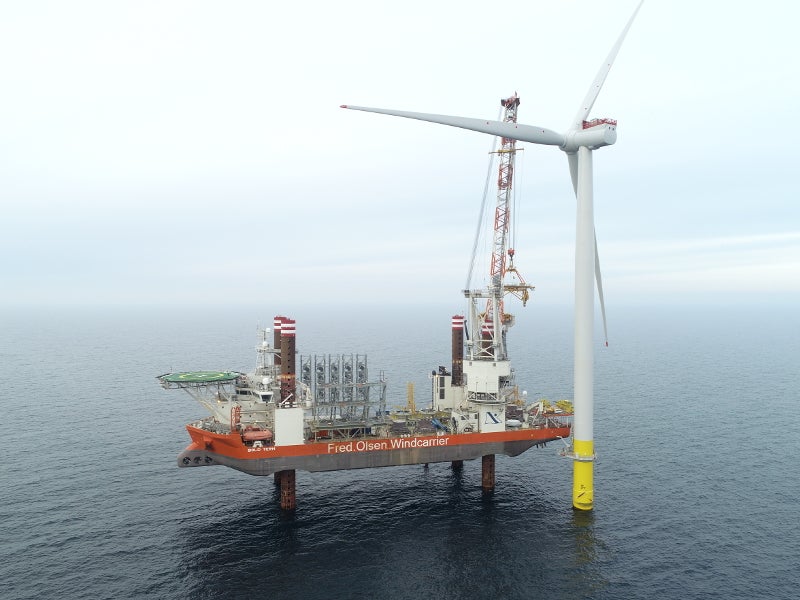
Offshore wind power has come a long way since the first offshore wind turbine was installed off the coast of Denmark in 1991.
The UK is the global leader in offshore wind with 34% of the world’s capacity off its coast. It also has Walney Extension off the coast of Cumbria, the largest offshore windfarm in the world with a capacity of 659MW.
But what are some of the offshore windfarms of the future? Power Technology takes a look at five windfarms currently under construction that could change the future of the sector.
Hornsea One, UK
Hornsea One is located in the North Sea and is scheduled for completion in June 2020.
The windfarm is formed of 174 7MW wind turbines made by Siemens Gamesa Renewable Energy (SGRE) and will have a total capacity of 1.2GW. The project is a joint venture between Ørsted and Global Infrastructure Partners and is part of a £6bn investment project for the Humberside region of the UK.
Hornsea One will break the world record of being the furthest offshore windfarm from the shore in the world, at 120km from the English coast. When complete it will be able to power one million homes in the UK and have a 25-year lifespan.

US Tariffs are shifting - will you react or anticipate?
Don’t let policy changes catch you off guard. Stay proactive with real-time data and expert analysis.
By GlobalDataEast Anglia One, UK
As the global leader in offshore wind, the UK is home to several of the leading offshore windfarms of the future.
The second one is our list is East Anglia One windfarm, which will be located 43km off the coast of Suffolk in the North Sea. East Anglia One will have a capacity of 714MW from 102 turbines, also built by SGRE. Construction on the windfarm began in 2017 and it will become fully operational in 2020.
In August 2019 Macquarie Green Investment Group paid £1.6bn for a 40% stake in the windfarm, with Scottish Renewables owning the remaining 60%.
Both East Anglia and Hornsea One will be part of the UK government’s Offshore Wind Sector Deal, which plans for offshore wind power to provide 30% of the UK’s electricity by 2030.
Borssele windfarms 1 and 2, Netherlands
The Borssele offshore windfarms will be located off the coast of Zeeland province in the Netherlands. Borssele will have a total capacity of 752MW from its 94 8MW turbines provided by SGRE and is set to be completed by 2020.
Like Hornsea One, Borssele will be developed by Ørsted and will be able to power one million homes each year in the Netherlands.
Borssele is part of the Dutch government’s Energy Agreement for Sustainable Growth plan, which was launched in 2013 to develop 3.5GW in offshore wind power by 2023.
The Borssele windfarm zone (BWZ) will also include Borssele windfarms 3 and 4 to give a total capacity of 1.4GW, with other windfarm zones located off the North (700MW) and Southern Holland (1400MW) coast.
Kriegers Flak, Denmark
Home of wind energy powerhouses Ørsted and Vestas, Denmark will also be home to the 600MW Kriegers Flak offshore windfarm when it becomes operational in 2020.
It has been developed by Swedish energy company Vattenfall, with 113 turbines again provided by SGRE. Vattenfall won ownership of the windfarm with a then record low bid at auction of €49.90 per MWh.
Kriegers is expected to cost DKK3.5bn ($513m), with €150m ($164m) coming from the European Economic Recovery Programme. Once complete it will be able to provide power to 600,000 homes per year.
Vineyard offshore wind, US
One of the first major offshore windfarms in the US, Vineyard offshore windfarm will be located off the coast of New York and have a capacity of 800MW. It is a joint venture between Avangrid and Copenhagen Infrastructure Partners and is planned to be completed in 2021.
However, unlike the other windfarms mentioned, Vineyard is in the most precarious position as the project has been held up by interagency disputes within the US government.
In July 2019 The National Oceanic and Atmospheric Administration (NOAA) and National Marine Fisheries Service (NMFS) refused to approve the project, whilst the US Department of the Interior (DOI) delayed it further in August 2019 in order to conduct further studies on its potential impact on the US coast.
Questions remain whether the delay is being used to deliberately kill the project, but despite these teething problems it is still estimated that the US will have the fourth largest offshore wind capacity by 2030.



